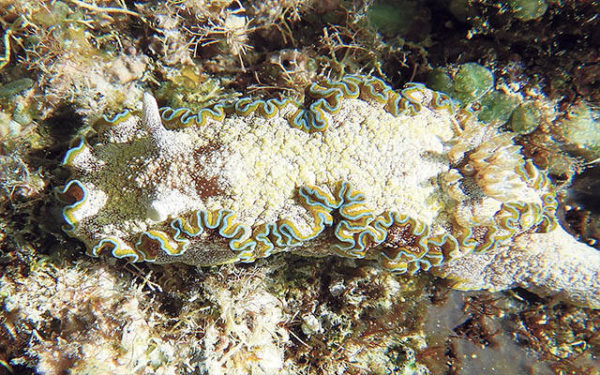Published in the Ocean Watch column, Honolulu Star-Advertiser © Susan Scott
March 17, 2018
One of my snorkeling companions in Palau told me her goal of her trip there was to see nudibranchs. But when I found a stunning one, and called to Susan and the eight others to come see it, no one showed up. So there I was, floating in 3 feet of water, breathless over my discovery and snapping pictures like crazy — all alone.
Nudibranchs (NUDIE- branks) are snails without shells. The common name of these animals is sea slugs — unfortunate because the word slug conjures up a slimy, brown image, and nudibranchs are some of the most beautiful creatures in the ocean.
Evolution has used the soft, naked backs of countless nudibranchs as canvases, filling them with nature’s masterpieces. Few of the thousands of nudibranch species have common names, but the ones that do paint vivid pictures: Spanish shawl, gold lace, snow-goddess, jolly green giant and so on. Nudies, as we admirers often call them, are orchids of the sea.
Nudibranchs are meat eaters, gliding around on their big, flat, muscular foot to graze on sponges, corals and jellyfish relatives called hydroids.
 Nudibranchs are snails without shells.
Nudibranchs are snails without shells.
The common name of these animals is sea slugs.
©2018 Susan Scott
Marine animals with bright colors are often poisonous, their colors warning potential predators that they’ll be sorry if they take a taste. The gaudy nudies rarely make their own poisons, but rather recycle them from their meals of stinging creatures, including Portuguese men-of-war, and sponges containing glasslike shards called spicules. Toxins also cover the surfaces of some sponges.
But not all nudies are poisonous. For protection, the tasty (to fish, not to us) species rely on camouflage, some matching their backgrounds so perfectly they’re hard to see even when someone is pointing right at them.
Hawaii hosts about a thousand nudibranchs, some species still unnamed. The excellent website “Sea Slugs of Hawaii,” lists names and photos of those found here in the islands.
Most nudibranchs are only an inch or so long, but some, like the relatively common brilliant red-orange Spanish Dancer, grow to 8 inches. The nudibranch I found was about 6 inches long.
No one came to see my gorgeous nudie because I had become so engrossed in watching it walk around, and photographing it, that I had missed our local guide’s call that it was time to go. When I finally looked up, there was my entire group sitting in the boat waiting for me on the far side of the reef.
One of the reasons I prefer snorkeling over scuba diving is that I can call out to friends when I find something fantastic. To share my discoveries, though, I have to pay attention to the location of my fellow snorkelers. With so much to see below, though, it’s hard to remember to look up.
The nudibranch I found is a Glossodoris aeruginosa, no common name. I call it my Miss-the-Boat nudie.